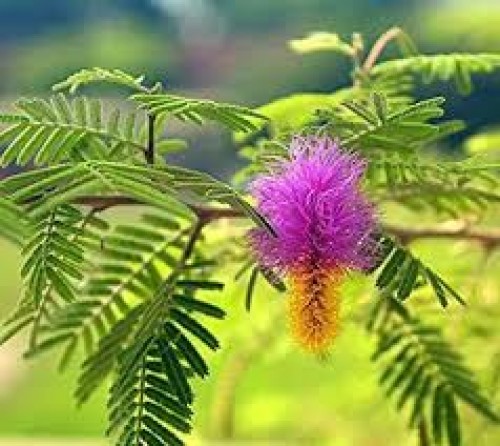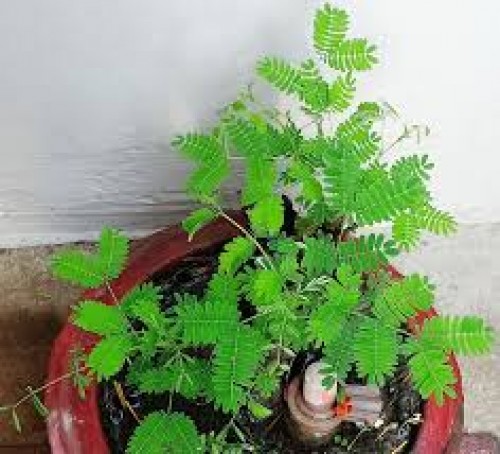off
-
Sold
-

-

out
Shami Plant: Nature, Care & Advantages
Shami (*Prosopis cineraria*) is a drought-resistant, evergreen tree native to arid regions of the Indian subcontinent and parts of Africa. It is also known as the "Indian mesquite" or "Khejri" in Hindi. The Shami plant is a hardy species that thrives in dry, sandy soils and is well-adapted to extreme heat. It holds religious and cultural significance, especially in Hinduism, where it is revered for its association with Lord Shiva. Shami trees are known for their dense canopy, small feathery leaves, and small greenish-yellow flowers, followed by pods containing edible seeds.
Nature of the Shami Plant
The Shami plant is a small to medium-sized tree that typically grows up to 10 meters tall. It has a thick, gnarled trunk with branches that spread out in a wide canopy, providing shade. The leaves of the plant are bipinnate, meaning they are feathery and finely divided. The Shami tree produces small, yellowish-green flowers that bloom in clusters, followed by long pods that contain small seeds. The seeds of the plant are edible and are used in various traditional food preparations. The tree has deep roots, which help it survive in dry and rocky soils. Its hardy nature makes it highly resistant to drought, pests, and diseases.
Care for the Shami Plant
- Climate: Shami trees thrive in hot, dry climates with temperatures ranging from 25°C to 45°C. They are well-suited to arid regions and can withstand drought conditions. However, they should be protected from frost during the winter months as they are sensitive to cold.
- Soil: Shami plants grow best in well-drained, sandy, or loamy soils. They are highly tolerant of poor soil conditions and can grow in saline or alkaline soil, making them ideal for desert regions or barren lands.
- Watering: Being drought-resistant, Shami plants do not require frequent watering. Once established, they can survive with minimal water. However, during extended dry spells, it is beneficial to water the tree moderately to ensure its health and growth. Over-watering should be avoided as it may cause root rot.
- Sunlight: The Shami plant thrives in full sunlight. It requires at least 6-8 hours of direct sunlight each day to grow well. It is highly tolerant of heat and direct sun exposure, making it suitable for hot, sunny areas.
- Pruning: Shami plants do not require frequent pruning, but it is helpful to remove dead, damaged, or crossing branches to maintain the tree’s shape and health. Light pruning can also help in promoting new growth and improving the structure of the tree.
- Propagation: Shami trees can be propagated through seeds or cuttings. The seeds are typically sown directly into the soil, while cuttings can be taken from mature branches. It is important to ensure proper soil drainage when planting Shami seeds or cuttings.
Advantages of the Shami Plant
- Medicinal Uses: Shami has several medicinal uses, especially in Ayurveda. The bark, leaves, and pods of the tree are used in various herbal remedies. It is known to help with digestive disorders, urinary problems, and respiratory conditions. The plant is also used as a natural anti-inflammatory and antiseptic.
- Cultural and Religious Significance: In Hinduism, the Shami tree is sacred and is associated with Lord Shiva. It is traditionally worshipped during the festival of Dussehra, symbolizing the victory of good over evil. The leaves and branches of the tree are used in religious ceremonies, and the tree is planted near temples.
- Soil Erosion Control: Shami trees have deep, strong roots that help in preventing soil erosion in dry and barren lands. They are often planted in desert reclamation projects and are valuable for restoring degraded soils in arid regions.
- Edible Seeds: The seeds of the Shami tree are edible and can be ground into flour or used in traditional food preparations. The seeds are rich in proteins and can be an important source of nutrition in drought-prone areas where other food sources may be scarce.
- Shade and Shelter: Shami trees provide valuable shade in hot, arid environments. Their dense canopy offers relief from the scorching sun and provides shelter to humans, animals, and insects in the desert. The tree's shade is especially beneficial in rural and remote areas.
- Wood for Fuel: The wood of the Shami tree is dense and durable, making it ideal for use as firewood. It is commonly used in rural areas for cooking and heating. Additionally, the wood can be used for making charcoal and construction materials.
- Wildlife Habitat: The Shami plant supports a variety of wildlife by providing a habitat for birds, insects, and small animals. Its flowers attract pollinators such as bees and butterflies, while its pods serve as a food source for various species.
Conclusion
The Shami plant is an incredibly valuable tree, both ecologically and culturally. Its ability to thrive in harsh, dry conditions makes it an ideal choice for afforestation and soil conservation projects in arid regions. With its medicinal benefits, edible seeds, and cultural significance, the Shami tree is not only beneficial for the environment but also for communities that rely on it for sustenance and spiritual practices. By understanding its care needs and advantages, the Shami plant can be an excellent addition to gardens, farms, and rural landscapes.